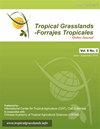在加勒比热带条件下饲养的羔羊,增加颗粒中巨毛线虫叶片浓度对草加颗粒饲料的营养价值和短期摄入量的影响
IF 0.7
4区 农林科学
Q3 AGRICULTURE, DAIRY & ANIMAL SCIENCE
引用次数: 0
摘要
目前,关于在加勒比热带条件下饲养的羔羊提供的颗粒饲料中增加巨茶毛犀叶浓度的益处的信息有限。选用12只5月龄杂交巴巴多斯黑腹公羊,研究提高颗粒饲料中巨茶霉浓度对草料加颗粒饲料营养价值和羔羊采食量的影响。实验动物被随机分配到基本饲粮(4公斤)切碎的紫花鸡,加上6种颗粒饲粮中的1种(500克),颗粒饲粮由100%完整的商业颗粒或磨碎的商业颗粒和磨碎的(干落的)巨型茶叶的颗粒混合物组成,比例如下(巨型茶叶:磨碎的商业颗粒):20:80 (T20);40:6 0 (T40);诸如比例(T60);80:20 (T80);100:0 (T100)。试验7 d,每天结束时测定饲粮和颗粒料总采食量(TPI),计算不同处理饲粮的平均日营养物质采食量。总体而言,含有0%和80%巨巨茶叶的微丸的采食量差异不显著(P< 0.05),但含有100%巨巨茶叶的微丸的采食量显著降低(P<0.0001)。CP和可溶性蛋白的摄入量随着巨茶叶在微球中所占比例的增加而逐渐下降。虽然喂给羔羊的颗粒中巨茶叶的含量通常不会影响颗粒、草或草+颗粒的总摄入量,但在进行长期喂养研究之前,不能认为这些不同饲料的动物性能是相似的,因为随着颗粒中叶子含量的增加,颗粒中蛋白质和能量浓度的降低会显著降低体重增加。本文章由计算机程序翻译,如有差异,请以英文原文为准。
The effects of increasing concentrations of Trichanthera gigantea leaves in pellets on the nutritive value and short-term intake of diets of grass plus pellets offered to lambs reared under tropical conditions in the Caribbean
There is currently limited information on the benefits of increasing the concentration of Trichanthera gigantea leaves in pelleted diets offered to lambs reared under tropical conditions in the Caribbean. Twelve crossbred Barbados Blackbelly rams aged 5 months were used to determine the effects of increasing the concentrations of T. gigantea in pelleted diets, on the nutritive value and intake of grass forage plus pellets offered to lambs. Animals were randomly assigned to a basic diet (4 kg) of chopped Cenchrus purpureus plus 1 of 6 pelleted diets (500 g) comprised of either 100% intact commercial pellets or a pelleted mixture of ground commercial pellets and ground (dry fallen) T. gigantea leaf in the following ratios (T. gigantea leaves:ground commercial pellets): 20:80 (T20); 40:60 (T40); 60:40 (T60); 80:20 (T80); and 100:0 (T100). Total intakes of forage and pellets (TPI) were measured at the end of each day during a period of 7 days, and the average daily nutrient intakes of the different treatment diets were calculated. Overall, there was no significant difference in the intakes of pellets containing 0 to 80% T. gigantea leaves (P>0.05) but intakes of pellets comprising 100% T. gigantea leaves were significantly lower (P<0.0001). Both CP and soluble protein intakes declined progressively as the percentage of T. gigantea leaves in the pellets increased. While level of T. gigantea leaves in pellets fed to lambs did not generally affect total intakes of pellets, grass, or grass+pellets, animal performance on these various rations cannot be assumed to be similar until longer-term feeding studies have been performed, as reduced protein and energy concentrations in the pellets could significantly lower weight gains as level of leaf in the pellets increased.
求助全文
通过发布文献求助,成功后即可免费获取论文全文。
去求助
来源期刊

Tropical Grasslands-Forrajes Tropicales
Agricultural and Biological Sciences-Agronomy and Crop Science
CiteScore
1.60
自引率
0.00%
发文量
36
审稿时长
16 weeks
期刊介绍:
The Journal publishes, in English or Spanish, Research Papers and Short Communications on research and development, as well as contributions from practitioners (Farmer Contributions) and Review Articles, related to pastures and forages in the tropics and subtropics. There is no regional focus; the information published should be of interest to a wide readership, encomprising researchers, academics, students, technicians, development workers and farmers.
In general, the focus of the Journal is more on sown (''improved'') pastures and forages than on rangeland-specific aspects of natural grasslands, but exceptions are possible (e.g. when a submission is relevant for a particularly broad readership in the pasture and forage science community).
The Journal will also consider the occasional publication of associated, but closely related, research in the form of an additional scientific communication platform [e.g. a re-make of the former Genetic Resources Communication series of the former Division of Tropical Crops and Pastures of the Commonwealth Scientific and Industrial Research Organisation (CSIRO), Australia].
Areas of particular interest to the Journal are:
Forage Genetic Resources and Livestock Production[...]
Environmental Functions of Forages[...]
Socio-economic Aspects[...]
Topics within the aforementioned areas may include: Diversity evaluation; Agronomy; Establishment (including fertilization); Management and utilization; Animal production; Nutritive value; Biotic stresses (pests and diseases, weeds); Abiotic stresses (soil fertility, water, temperature); Genetics and breeding; Biogeography and germplasm collections; Seed production; Ecology; Physiology; Rhizobiology (including BNF, BNI, mycorrhizae); Forage conservation; Economics; Multilocational experimentation; Modelling.
 求助内容:
求助内容: 应助结果提醒方式:
应助结果提醒方式:


